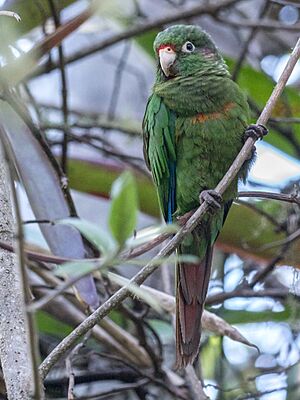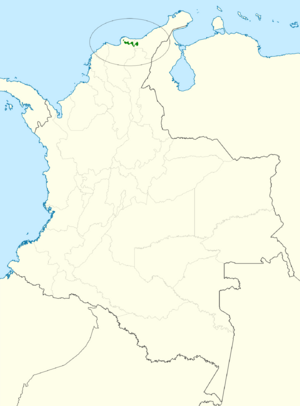Santa Marta parakeet facts for kids
Quick facts for kids Santa Marta parakeet |
|
|---|---|
 |
|
| Conservation status | |
| Scientific classification | |
 |
The Santa Marta parakeet (Pyrrhura viridicata) is a special type of parrot. It is an endangered bird, which means there are not many left in the world. This parakeet lives only in Colombia.
Contents
About the Santa Marta Parakeet
The Santa Marta parakeet is a member of the parrot family, Psittacidae. It belongs to a group of parrots called Arinae, which are found in Africa and the Americas. Scientists are still learning about its exact family tree. This parakeet is a "monotypic" species, meaning it is the only one of its kind in its group.
What Does It Look Like?
The Santa Marta parakeet is about 23 to 25 centimeters (9 to 10 inches) long. Both male and female parakeets look the same.
They have a mostly green head with a red forehead. Their ears are covered with brownish feathers. The top part of their body is green.
A cool feature is the bright scarlet, or red, "belt" across their chest and upper belly. The rest of their underside is green. Their wings are mostly green, but the feathers underneath and on top can be yellow or orange. The main flight feathers are blue. Their tail is a dull reddish color.
Young parakeets look similar to the adults, but they do not have the red belt on their belly.
Where Do They Live?
The Santa Marta parakeet lives only in the Sierra Nevada de Santa Marta. This is a mountain range in northern Colombia that stands alone. It is not connected to other mountain ranges.
These parakeets prefer to live in humid forests on the sides of mountains. They like areas that get a lot of rain, usually more than 2,000 millimeters (79 inches) each year. They also sometimes live in forests that have grown back after being cut down, or in farm areas. You can find them at high elevations, between 2,000 and 3,500 meters (6,500 to 11,500 feet) above sea level.
How They Behave
Movement and Travel
The Santa Marta parakeet does not fly long distances to different places for seasons, like some birds do. Instead, it moves around a bit within its mountain home. It travels to find its favorite foods when they are available.
What They Eat
These parakeets enjoy eating many different fruits and seeds. A big part of their diet is the fruit from a plant called Croton bogotanus. They also eat flowers, leaves, and even lichens.
They usually look for food in groups of up to 20 birds. Their diet changes depending on what food is easy to find. If their favorite foods are not around, they will eat other things. This shows they are good at adapting to what is available.
Reproduction and Life Cycle
In nature, Santa Marta parakeets build their nests inside dead wax palms (Ceroxylon ceriferum). They also use special nest boxes that people place in or near the forest.
They have two main times of the year when they lay eggs. One is from December to May, and the other is from June to October. The second breeding time might happen because they compete with bigger parrots for nesting spots.
A female parakeet usually lays between three and seven eggs. On average, they lay about 4 or 5 eggs. The eggs hatch after 22 to 28 days. The young birds are ready to fly about 45 days after they hatch. These parakeets also show "cooperative breeding," which means other birds, not just the parents, help raise the young.
Sounds They Make
When Santa Marta parakeets fly, they make loud, screeching calls.
Why They Are Endangered
The IUCN (International Union for Conservation of Nature) has listed the Santa Marta parakeet as an Endangered species since 2000. This means they are at high risk of disappearing forever.
There are only about 1,800 to 3,200 adult parakeets left. Their numbers are getting smaller. About half of their original forest home has been cut down. This land is often used for planting trees that are not native to the area, like pine and Eucalyptus, or for creating pastures for farm animals.
People sometimes hunt these birds or try to catch them for pets. However, these activities are not the main reasons for their decline. The biggest problem is the loss of their habitat.
About 80% of these parakeets live in the Sierra Nevada de Santa Marta National Natural Park. There are also some in two private protected areas. Even though they are in a national park, protecting their home completely is still a challenge.
See also
 In Spanish: Cotorra de Santa Marta para niños
In Spanish: Cotorra de Santa Marta para niños



